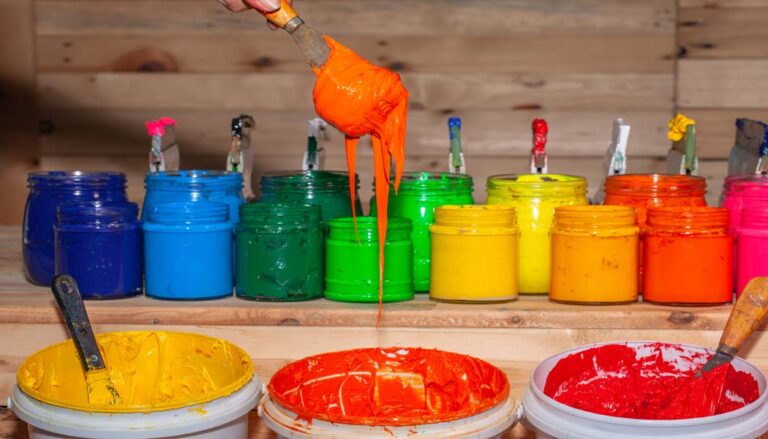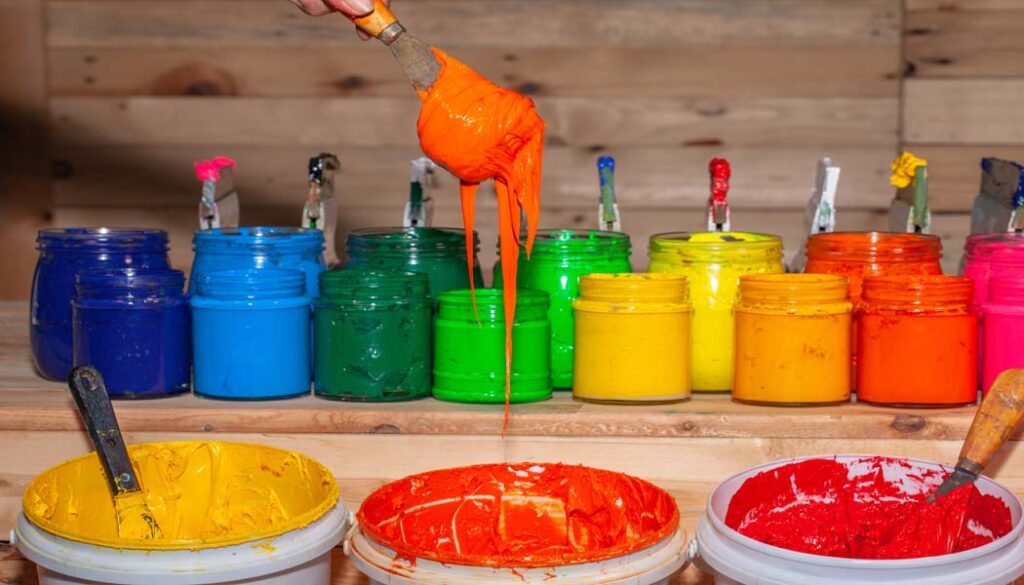
Can You Use Screen Printing Ink as Fabric Paint?
Are you a DIY enthusiast looking to add some personal flair to your fabric crafts? You are left with some screen printing ink, but not sure if you can use it on the fabric instead of fabric paint. And this question comes in your mind – can you use screen printing ink as fabric paint?
Screen printing ink can be used as fabric paint, but the result will not be that satisfactory. Screen printing ink is thicker and not flexible as fabric paint. And this ink is specially designed for utilization in screen printing methods. So, it will not be wise to use it on fabric.

In this blog, we’ll explore some vital points so that you achieve optimal results from screen printing ink if you don’t have fabric paint at hand at the moment. So, let’s dive in and uncover the world of screen printing ink and fabric paint!
Can You Use Screen Printing Ink as Fabric Paint?
Before we delve into whether you can use screen printing ink as fabric paint, let’s take a moment to explore what these two products are.
Screen Printing Ink:
Screen printing ink is a type of ink that is specifically designed for use with screen printing techniques. It is a thick, opaque ink that is applied to fabrics using a mesh screen and a squeegee. Screen printing ink is available in a range of colors, and can be used to create detailed designs on fabrics.
Fabric Paint:
Fabric paint, on the other hand, is a type of paint that is specifically designed for use on fabrics. It is available in a range of colors and can be applied directly to fabrics using a brush or applicator. Fabric paint is designed to be flexible and durable and can be used to create detailed designs or patterns on fabrics.
Now let’s come to the topic of our discussion: “can you use screen printing ink as fabric paint”. While it is technically possible to use screen printing ink as fabric paint, it may not produce the desired results.
Screen printing ink is often thicker and less flexible than fabric paint, which can result in cracking and fading over time. Additionally, the screen printing ink is designed to be used with screen printing techniques, so it might be hard to apply directly to fabric.
But what happens if someone insists on using screen printing ink as fabric paint? Well, if someone insists on using screen printing ink as fabric paint, they may find that the results are less than optimal.
Screen printing ink’ thick consistency makes it hard to apply evenly to fabrics and may fade or crack over time. Additionally, using screen printing ink in this way may damage the fabric or affect its texture.
What if you used different types of fabric? Will the results be the same? Yes, the type of fabric used can affect the results of using screen printing ink as fabric paint. Some fabrics may not absorb the ink evenly, resulting in a patchy or uneven appearance. Additionally, different fabrics may require different application techniques or types of ink, depending on their texture, weave, and other properties. So, trying different fabrics may not improve the results!
Is there a technique to help achieve satisfactory results with screen printing ink? There are a few techniques that can help you achieve satisfactory results when using screen printing ink as fabric paint. One is to dilute the ink with water or fabric medium to make it thinner and more flexible.
Another is to use a heat press to set the ink into the fabric, which can help to reduce cracking or fading over time. Additionally, practicing on scrap fabric before applying the ink to your final project can help you fine-tune your application technique and achieve better results.
To sum it up, we say, though it is possible to use screen printing ink as fabric paint, it may not produce the best results. Fabric paint is specifically designed to be flexible, durable, and easy to apply directly to fabrics.
However, with the right techniques and practice, it is possible to achieve close to satisfactory results with screen printing ink on certain types of fabric. It’s always best to choose the right product for the job and use it as directed for the best possible results.
Is There Any Similarity between Printing Ink and Fabric Paint?
While there are notable differences in the composition and intended use of screen printing ink and fabric paint, they also share some similarities.
Both screen printing ink and fabric paint are used for decorating fabric surfaces. They can be used to create a range of designs and patterns and can be applied to various types of fabrics, such as cotton, silk, and polyester. Additionally, both ink and paint can be used to create custom designs and logos for clothing, bags, and other fabric-based products.
However, it’s important to note that though there may be some similarities in their application, the composition and properties of the two are quite different.
What Are the Differences between Printing Ink and Fabric Paint?
Though screen printing ink and fabric paint may seem similar at first glance, there are notable distinctions between the two that can impact their use and effectiveness. Understanding these differences can help you choose the right type of ink or paint for your specific project and achieve optimal results.
In this section, we’ll explore some key differences between them, from their composition and application methods to their texture and durability.
- Composition: Screen printing ink typically has a higher pigment concentration, which makes it more opaque and suitable for printing on a range of materials. Fabric paint, on the other hand, has a lower pigment concentration and is designed to be applied by hand to fabric surfaces.
- Method of application: Screen printing ink is usually applied using a screen printing process, which involves transferring the ink onto the fabric through a stencil. Fabric paint is often applied by hand using a brush, fabric pen, or other tools.
- Texture and finish: Screen printing ink can produce a smoother, more uniform texture on fabric surfaces due to its high pigment concentration and application method. Fabric paint, on the other hand, can create a range of textures and finishes depending on the application method and type of paint used.
- Colorfastness and durability: Fabric paint is typically more colorfast and durable than screen printing ink, making it a better option for fabrics that will be washed frequently or exposed to the elements.
Can You Use a Brush with Screen Printing Ink?
You can use a brush with screen printing ink, but the results may not be optimal. Screen printing ink is designed for getting transferred onto fabric through stencils. Using a brush to apply this ink can result in a less precise application and may cause the ink to bleed or smudge.
Additionally, as we said earlier, the screen printing ink is typically thicker than fabric paint, so it may not flow as well through a brush. If you need to apply ink by hand, it’s generally better to use fabric paint, which is designed for this purpose and can produce better results.
Final Words
While screen printing ink can be used as fabric paint in a pinch, it’s generally not recommended as it may not produce optimal results. For best results, it’s recommended to use fabric paint for hand applications or screen printing ink for screen printing processes.
In the blog, we talked about the differences between the two. And by understanding these differences, you can choose the right type of ink or paint for your specific needs and achieve the best possible results.
